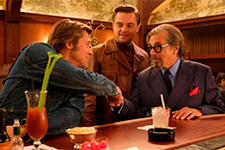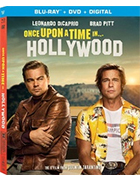Once Upon a Time ... in Hollywood
|  During the opening credits of Quentin Tarantino’s Palm d’Or-winning sophomore film Pulp Fiction (1994), the soundtrack switches abruptly from Dick Dale and His Del-Tones’ 1962 guitar-heavy surf rocker “Misirlou” to Kool & the Gang’s 1973 funk jam “Jungle Boogie.” It’s an unexpected bit of sonic playfulness, moving suddenly between genres in the guise of changing a radio station using old-fashioned knobs (so we hear the static and bits of other stations between the two songs), as if Tarantino had changed his mind mid-way about scoring the opening credits. Most of Tarantino’s films operate along a similar logic, the cinematic equivalent of scanning through radio stations and picking up bits and pieces of different genres and styles without ever knowing exactly where you’re going to land and how long you might stay there. That tendency was already deeply embedded in Tarantino’s first film, Reservoir Dogs (1992), which infamously lurched from comic setpieces about heavies discussing the deeper meaning of Madonna pop songs, to graphic torture in which a cop’s ear is sawed off with a straight razor, although the fact it was confined largely to a single setting gave it a sense of containment that Tarantino has sought to discard in most of his subsequent films (2015’s 70mm Western The Hateful Eight, which unfolds almost entirely within a snowed-in mountain cabin, being the lone exception). What Tarantino has sought most in his films is sprawl—sprawling casts of characters, sprawling locations, sprawling dialogue, sprawling violence, sprawling tones and themes and genre homages. It’s the thing that his fans adore and his detractors write off as pop culture juvenilia—in other words, it is what best defines his art. Once Upon a Time … in Hollywood, Tarantino’s latest (and, by his admission, possibly his last) film, simultaneously amplifies and clarifies that tendency by giving us a sprawling set of interlocking narratives featuring a huge cast of characters that are bound together by a singular time and place: Los Angeles in the late 1960s, the L.A. of Tarantino’s childhood and the time period that produced most of the genres about which he has obsessed via cinematic homage over the past two and a half decades: spaghetti westerns, kung-fu movies, blaxploitation. Much of the pleasure in Once Upon a Time … in Hollywood derives from Tarantino’s exquisite recreation of Hollywood at the end of an era, when the old studio system was on its last legs, collapsing economically and ideologically as it turned the reins over to a new generation of writers, directors, producers, and studio executives. The film is a, to borrow Tarantino’s own verbiage from his introduction on the Criterion Collection laserdisc edition of Pulp Fiction (how’s that for geeky?), a “cavalcade, a cornucopia, a literal horn o’ plenty” of late ’60s pop culture. From the cars, to the clothes, to the hairstyles, to the home décor—everything is perfectly, lovingly in place, and Tarantino packs the film with references to movies and television and music both familiar and obscure (marquees and posters and billboards in the background remind us of the existence of movies such as The Night They Raided Minsky’s, The Illustrated Man, Ice Station Zebra, Candy, and 3 in the Attic). The soundtrack is a particularly intriguing device, as it is constantly humming with advertisements and songs, a reminder that radio was once the tie that bound. Interestingly, though, the movie industry does not provide the film its primary backdrop. Rather, it is television production, where we find the film’s protagonist, a middle-aged star named Rick Dalton (Leonardo DiCaprio), languishing. Rick became a major small-screen star in the 1950s on a western series called Bounty Law (clearly modeled on the 1958–1961 series Wanted: Dead or Alive, which launched Steve McQueen’s career) and then tried and mostly failed to make the transition into feature films (he starred in a few forgettable action romps, including one where he wears an eyepatch and decimates a room full of Nazis with a flamethrower). He is now relegated to a kind of purgatory of guest-starring roles on other TV series, usually as the heavy, which his brash agent Marvin Schwarz (Al Pacino) warns him is a one-way ticket to career oblivion. The one thing Rick can count on is Cliff Booth (Brad Pitt), his former stunt double and best buddy who now works as his driver and all-around gopher. They are a perfectly matched odd couple: Rick is the high-strung, edgy actor on the brink of collapse, while Cliff is laid-back and laconic, cool with just about anything that comes his way. DiCaprio and Pitt have real chemistry here, and Tarantino conveys their bromance in a way that is both comical and endearing. Tarantino’s world has always been intensely homosocial (the only thing even remotely close to a male-female romance is 1997’s Jackie Brown), but his male buddies have often operated largely in tension, rather than unanimity (think Jules and Winston’s constant bickering in Pulp Fiction). Rick and Cliff are soul mates in their own way, which gives Once Upon a Time … in Hollywood an endearing quality we don’t usually associate with the Tarantino-verse. Running parallel to Rick’s narrative is that of his Cielo Drive next-door neighbor Sharon Tate (Margot Robbie), the real-life actress and then-wife of director Roman Polanski who, on the fateful night of August 9, 1969, became one of the victims of the Manson “family.” Tate is something of a peripheral character, clearly secondary to Rick’s fall-and-rise storyline, but Tarantino gives her just enough space and screen time to make an impression and thus increase our concern for her eventual fate. In an extended sequence in the middle of the film, Tate notices that a downtown theater is playing the 1968 Dean Martin action comedy The Wrecking Crew, in which she plays a supporting role. She decides to go in and watch it, and the genuine delight she feels in the audience reaction to her performance has a radiating quality that makes her imminently appealing. Some critics have dismissed her character as a “bimbo,” but she strikes me as sincere and uncorrupted; her enjoyment of others enjoying her work is evidence of her complete lack of pretension. And, of course, we also have the Manson “family,” whose various members appear throughout the early portions of the film (including Charlie himself, who wanders up to the Tate-Polanski house looking for its former occupants). Cliff gives a ride to Pussycat (Margaret Qualley), one of the Manson girls, and ends up at Spahn Ranch, the old western movie set where the Manson family made their home and where he and Rick had shot Bounty Law. Like the tense opening interrogation sequence in Inglorious Basterds (2009), Tarantino builds the suspense and tension of looming violence, but regularly punctuates it with bits of pitch-perfect black comedy revolving around the contrast between Cliff’s laid-back demeanor and the soon-to-be murderous cult in whose midst he finds himself. Determined to see if the ranch’s elderly owner, George Spahn (Bruce Dern), is alright, Cliff butts heads with Manson followers Charles “Tex” Watson (Austin Butler) and Lynette “Squeaky” Fromme (Dakota Fanning), but never bats an eye behind his avaitors. Pitt has long been undervalued as a comic actor, but Tarantino clearly knows how to simultaneously emphasize and undercut his movie-star wattage (he did the same thing in Inglourious Basterds, and let’s not forget that Pitt stole several scenes as a long-haired stoner in the Tarantino-penned True Romance back in 1993). These various narrative strands interweave throughout the film’s lengthy running time (like most of Tarantino’s films, it clocks in at well over two and a half hours), and while there are some digressions that feel meaningless on first blush (including a sequence in which Cliff goes toe-to-toe with a comically conceited Bruce Lee, played by Mike Moh), the movie never sags. There is method to the narrative madness (or, at least, I think there is), which multiple viewings will surely reveal, and cinematographer Robert Richardson, who has shot all of Tarantino’s films since Kill Bill (2003), throws it all on the table with elaborate crane and tracking shots that keep the film moving, moving, moving. Anyone who knows contemporary American history knows where things are headed, and if Tarantino decided to stick with the historical record, Once Upon a Time … in Hollywood would have ended on the biggest downer imaginable. That, of course, is not what happens, and Tarantino’s version of the night of August 9, 1969, turns out much different than the real deal, albeit no less violent. It’s an unabashedly hubristic move on his part to take a tragedy that still feels raw five decades later and recalibrate it into an audience-pleasing orgy of violent historical revisionism (the audience with which I saw it theatrically was roaring in approval), but you can’t blame Tarantino for wanting to go out with a bang. Interestingly, though, when the blood has dried and the bodies have been carted off, he gives us an endearing denouement that offers another bit of “what if?,” this one intended not to quench our thirst for righteous vengeance, but rather our desire to see innocence persist in the midst of evil. It may be the sweetest thing Tarantino, that postmodern purveyor of pop culture juvenilia, has ever done.
Copyright © 2019 James Kendrick Thoughts? E-mail James Kendrick All images copyright © Sony Pictures Home Entertainment | |||||||||||||||||||||||||||||
Overall Rating: 


 (3.5)
(3.5)


